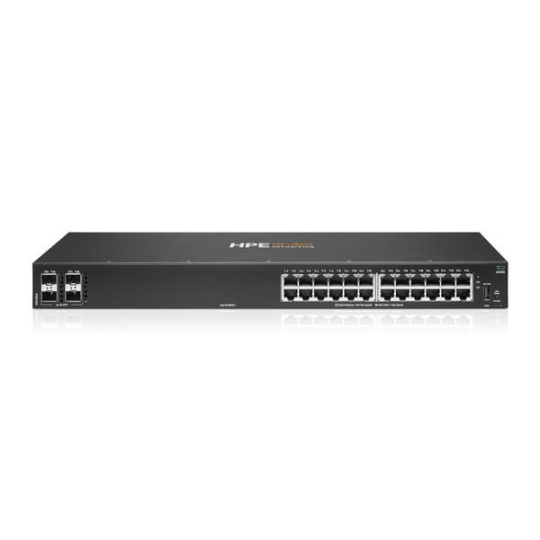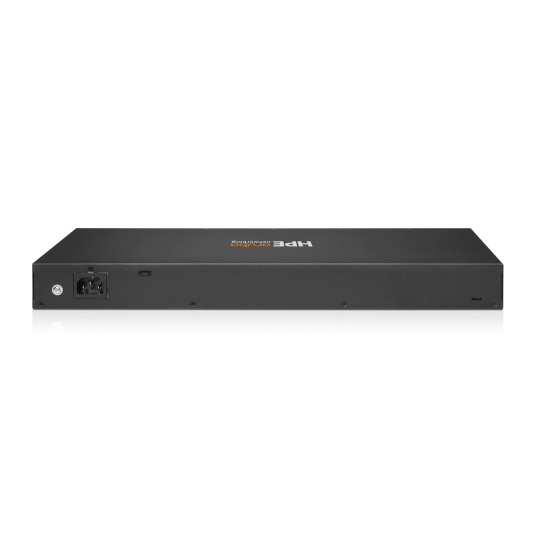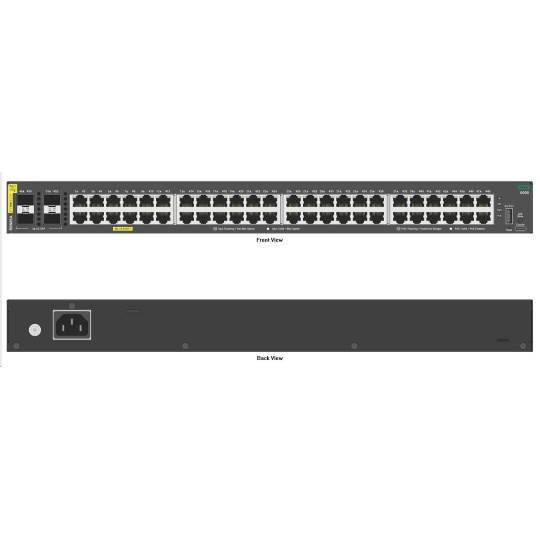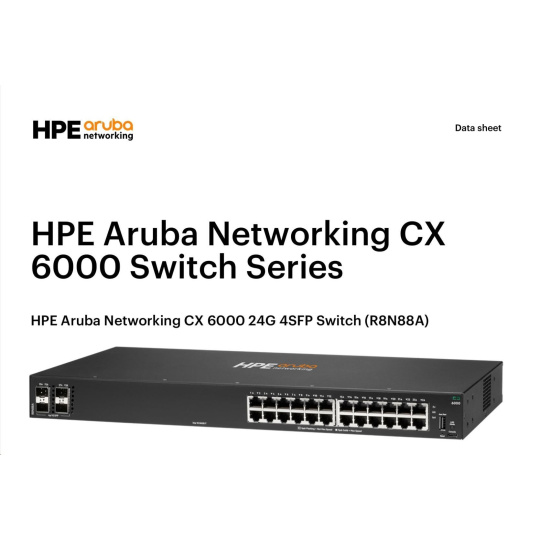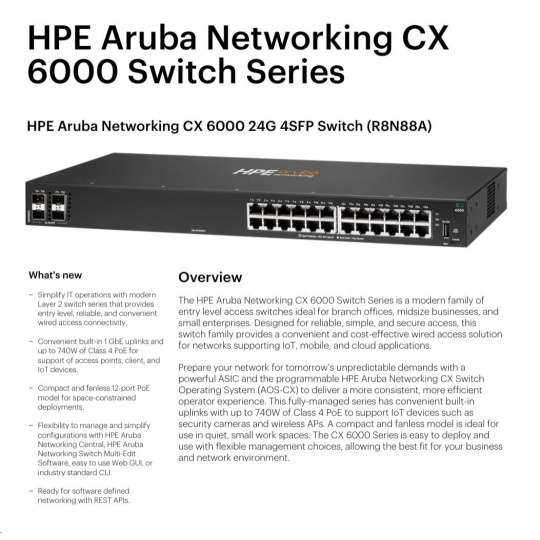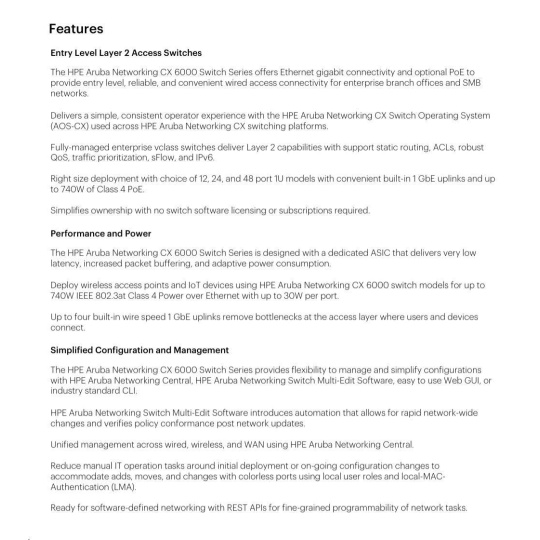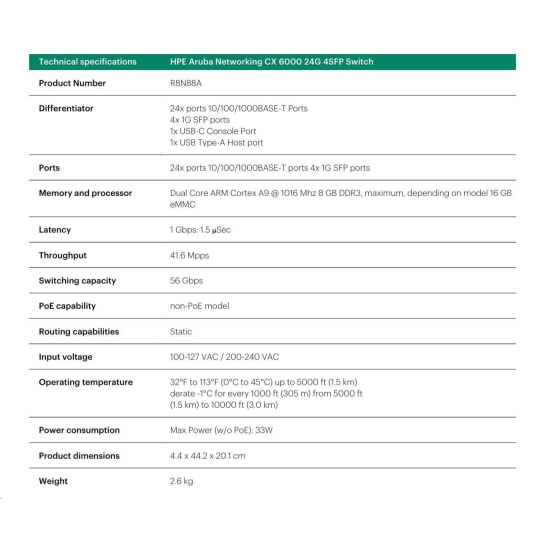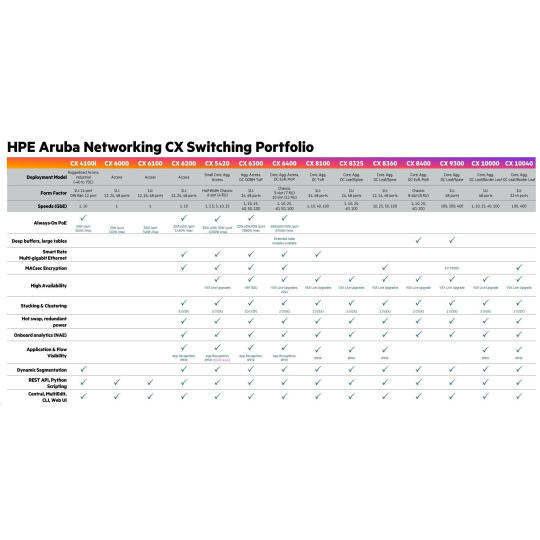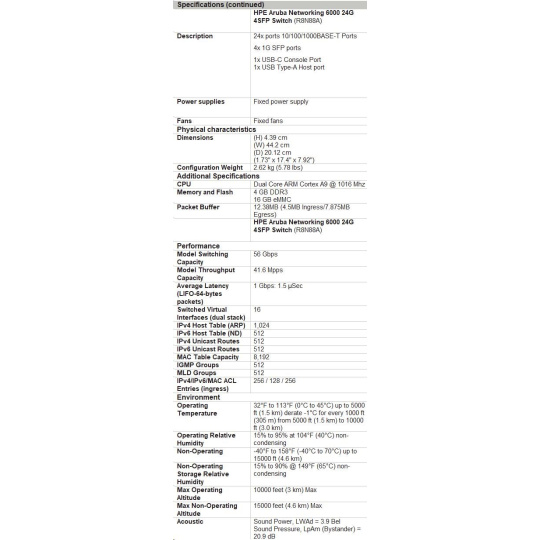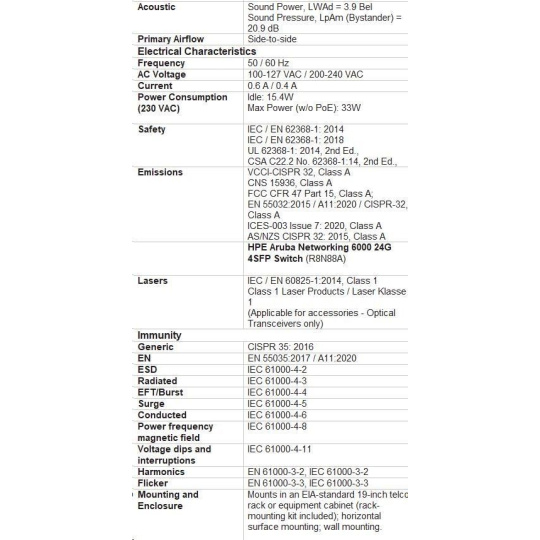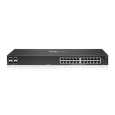HPE Aruba Networking CX 6000 24G 4SFP Switch R8N88A RENEW
HPE Aruba Networking CX 6000 24G 4SFP Switch R8N88A RENEW
HPE Aruba Networking 6000 Switch Specifications
| Specification | 6000 24G 4SFP Switch (R8N88A) |
|---|---|
| Description | 24x ports 10/100/1000BASE-T 4x 1G SFP ports 1x USB-C Console Port 1x USB Type-A Host port |
| Power supplies | Fixed power supply |
| Fans | Fixed fans |
| Physical dimensions (H x W x D) | 4.39 cm x 44.2 cm x 20.12 cm (1.73" x 17.4" x 7.92") |
| Weight | 2.62 kg (5.78 lbs) |
| CPU | Dual Core ARM Cortex A9 @ 1016 MHz |
| Memory and Flash | 4 GB DDR3, 16 GB eMMC |
| Packet Buffer | 12.38MB (4.5MB Ingress / 7.875MB Egress) |
| Switching Capacity | 56 Gbps |
| Throughput Capacity | 41.6 Mpps |
| Average Latency (LIFO-64-bytes packets) | 1 Gbps: 1.5 µSec |
| Switched Virtual Interfaces (dual stack) | 16 |
| IPv4 Host Table (ARP) | 1,024 |
| IPv6 Host Table (ND) | 512 |
| IPv4 Unicast Routes | 512 |
| IPv6 Unicast Routes | 512 |
| MAC Table Capacity | 8,192 |
| IGMP Groups | 512 |
| MLD Groups | 512 |
| IPv4/IPv6/MAC ACL Entries (ingress) | 256 / 128 / 256 |
| Operating Temperature | 32°F to 113°F (0°C to 45°C) up to 5000 ft (1.5 km) Derate -1°C for every 1000 ft (305 m) from 5000 ft to 10000 ft |
| Operating Relative Humidity | 15% to 95% at 104°F (40°C), non-condensing |
| Non-Operating Temperature | -40°F to 158°F (-40°C to 70°C) up to 15000 ft (4.6 km) |
| Non-Operating Storage Relative Humidity | 15% to 90% at 149°F (65°C), non-condensing |
| Max Operating Altitude | 10,000 feet (3 km) |
| Max Non-Operating Altitude | 15,000 feet (4.6 km) |
| Acoustic | Sound Power, LWAd = 3.9 Bel Sound Pressure, LpAm (Bystander) = 20.9 dB |
| Primary Airflow | Side-to-side |
| Frequency | 50 / 60 Hz |
| AC Voltage | 100-127 VAC / 200-240 VAC |
| Current | 0.6 A / 0.4 A |
| Power Consumption (230 VAC) | Idle: 15.4W Max Power (w/o PoE): 33W |
| Safety | IEC / EN 62368-1: 2014 UL 62368-1: 2014, 2nd Ed., CSA C22.2 No. 62368-1:14, 2nd Ed. |
| Emissions | VCCI-CISPR 32, Class A CNS 15936, Class A FCC CFR 47 Part 15, Class A; EN 55032:2015 / A11:2020 / CISPR-32, Class A ICES-003 Issue 7: 2020, Class A AS/NZS CISPR 32: 2015, Class A |
| Lasers | IEC / EN 60825-1:2014, Class 1 (For accessories - Optical Transceivers only) |
| Immunity | CISPR 35: 2016 EN 55035:2017 / A11:2020 IEC 61000-4-2 (ESD) IEC 61000-4-3 (Radiated) IEC 61000-4-4 (EFT/Burst) IEC 61000-4-5 (Surge) IEC 61000- |
HPE Aruba Networking CX 6000 Switch Series
The HPE Aruba Networking CX 6000 Switch Series is a modern family of entry-level access switches ideal for branch offices, midsize businesses, and small enterprises. Optimized for reliable, simple, and secure access, the CX 6000 Switch series provides a convenient and cost-effective wired access solution for networks supporting IoT, mobile, and cloud applications.
The CX 6000 Switch series is based on the HPE Aruba Networking ASIC architecture with the programmable AOS-CX operating system used across the entire HPE Aruba Networking CX portfolio for a more consistent, more efficient operator experience. This fully managed series has convenient built-in uplinks with up to 740W of PoE+ to support IoT devices such as security cameras and wireless APs. A compact and fanless model is ideal for use in quiet, small workspaces.
The HPE Aruba Networking CX 6000 Switch Series is easy to deploy and use with flexible management choices that include Web GUI, CLI, cloud-based and on-premises HPE Aruba Networking Central management, so you can choose the best fit for your business and network environment.
Delivering Layer 2 capabilities with enhanced access security, traffic prioritization, and IPv6 support, the CX 6000 also simplifies ownership and brings peace of mind with switch software embedded with no subscription required to enable and a Limited Lifetime Warranty.
Key Features
- Enterprise-class Layer 2 connectivity with support for ACLs, robust QoS, and static routing
- Convenient built-in 1GbE uplinks and up to 740W of Class 4 PoE for support of IoT devices
- Compact and fanless 12 port model for quiet deployment
- Management flexibility with support for HPE Aruba Networking Central, easy-to-use Web GUI, CLI, and HPE Aruba Networking NetEdit
- Simple deployment with Zero Touch Provisioning
- Software defined ready with REST APIs
- Simplify adds, moves, and changes with colorless ports
Standard Features
Product Differentiators
AOS-CX - A modern software system
The HPE Aruba Networking CX 6000 Switch Series is based on AOS-CX, a modern, database-driven operating system built on a modular Linux architecture. Benefits include:
- Easy access to all network configuration state information
- REST APIs for fine-grained programmability of network tasks
- A micro-services architecture enabling full integration with other workflow systems and services
- All software processes communicate with the database rather than each other, ensuring near real-time state and resiliency
HPE Aruba Networking ASICs - Programmable innovation
Based on over 30 years of continuous investment, HPE Aruba Networking's ASICs provide innovative software feature advancements, unparalleled performance, and deep visibility. The CX 6000 Switch Series uses this ASIC architecture for optimized performance and capacity.
Access Layer Performance
- Up to 104 Gbps non-blocking bandwidth and up to 77.3 Mpps forwarding
- Selectable queue configurations for optimized performance
- Management flexibility with cloud-based and on-premises options, CLI, and Web GUI
Simplify Adds, Moves and Changes
Reduce manual IT tasks with colorless ports using local user roles and local-MAC-Authentication (LMA). Colorless ports automatically apply required roles/policies instead of static VLAN mapping.
Cost-effective enterprise-class access
- Five fixed 1U models supporting 24 or 48 IEEE 802.3 1GbE access ports, with built-in uplink SFP ports
- PoE models supporting up to 370W (24 port) and 740W (48 port) IEEE 802.3at Class 4 PoE
- Compact fanless 12 port model with four uplinks and 139W PoE support
- Supports Energy Efficient Ethernet IEEE 802.3az, Auto-MDIX, Jumbo frames, and packet storm protection
Resiliency and Availability
- Uni-directional Link Detection (UDLD) to prevent STP loops
- IEEE 802.3ad LACP with up to 8 LAGs, each with up to 8 links
- IEEE 802.1s Multiple Spanning Tree Protocol (MSTP) and legacy STP support
- SmartLink link redundancy
Quality of Service (QoS) features
- Strict priority queuing
- Traffic prioritization (IEEE 802.1p)
- Class of Service (CoS) based on IP address, ToS, protocol, TCP/UDP port, source port, DiffServ
- Rate limiting with per-port ingress and queue minimums
- Large buffers for congestion management
Simplified Configuration and Management
Multiple management interfaces supported including Web GUI, CLI, cloud-based HPE Aruba Networking Central, REST API, and NetEdit automation tool.
Layer 2 and Layer 3 Features
The switch supports extensive Layer 2 VLAN, spanning tree protocols, port mirroring, multicast, and Layer 3 static routing, dual IPv4/IPv6 stack, and multicast protocols.
Security Features
- Integrated TPM for platform integrity
- IPv4 and IPv6 ACLs
- RADIUS, TACACS+ authentication
- IEEE 802.1X, MAC-based authentication, and multiple authentication schemes per port
- Secure management access with SSHv2, SSL, SNMPv3
- Control Plane Policing, DHCP snooping, ARP protection, port security, MAC pinning, and more
Convergence and PoE
- LLDP-MED for automatic device configuration
- Multiple PoE allocation methods for efficient power management
- Auto VLAN configuration for voice VLANs
Additional Information
Supports green initiatives such as RoHS and WEEE.
Support and Warranty
Limited Lifetime Warranty. For warranty and support details, visit HPE Aruba Networking Support Services. Software releases and documentation are available at HPE Networking Support.
Standards and Protocols
(Applies to all products in series)
- RFC 1591 DNS (client)
- SSHv1/SSHv2 Secure Shell
- IEEE 802.1D MAC Bridges
- IEEE 802.1p Priority
- IEEE 802.1Q VLANs
- IEEE 802.1s Multiple Spanning Trees
- IEEE 802.1w Rapid Reconfiguration of Spanning Tree
- IEEE 802.3 Type 10BASE-T
- IEEE 802.3ab 1000BASE-T
- IEEE 802.3ad Link Aggregation Control Protocol (LACP)
- IEEE 802.3at Power over Ethernet
- IEEE 802.3az Energy Efficient Ethernet
- IEEE 802.3x Flow Control
- RFC 768 UDP
- RFC 783 TFTP Protocol (revision 2)
- RFC 792 ICMP
- RFC 793 TCP
- RFC 826 ARP
- RFC 1350 TFTP Protocol (revision 2)
- RFC 2131 DHCP client
- RFC 4330 Simple Network Time Protocol (SNTP) v4
- RFC 951 BOOTP (VLAN 1 Only)
- RFC 1542 BOOTP Extensions (VLAN 1 only)
- IGMPv2/IGMPv3
- IGMP/MLD Snooping
- RFC 1981 IPv6 Path MTU Discovery for IPv6
- RFC 2460 IPv6 Specification
- RFC 2925 Remote Operations MIB (Ping only)
- RFC 3315 DHCPv6 (client only)
- RFC 3513 IPv6 Addressing Architecture
- RFC 3596 DNS Extension for IPv6
- RFC 3176 sFlow
- RFC 4022 MIB for TCP
- RFC 4113 MIB for UDP (Partially)
- RFC 4251 SSHv6 Architecture
- RFC 4252 SSHv6 Authentication
- RFC 4253 SSHv6 Transport Layer
- RFC 4254 SSHv6 Connection
- RFC 4293 MIB for IP
- RFC 4419 Key Exchange for SSH
- RFC 4443 ICMPv6
- RFC 4861 IPv6 Neighbor Discovery
- RFC 4862 IPv6 Stateless Address Auto-configuration
- RFC 1213 MIB
- RFC 1493 Bridge MIB
- RFC 2674 802.1p and IEEE 802.1Q Bridge MIB
(Partial support. MIB objects supported: ieee8021BridgeBasePort, ieee8021BridgeBasePort, ieee8021BridgePortMrpJoinTime, ieee8021BridgePortMrpLeaveTime, ieee8021BridgePortMrpLeaveAllTime)
- RFC 2737 Entity MIB
- RFC 2863 The Interfaces Group MIB
- IEEE 802.1AB Link Layer Discovery Protocol (LLDP)
- RFC 1098 A Simple Network Management Protocol (SNMP)
- ANSI/TIA-1057 LLDP Media Endpoint Discovery (LLDPMED)
- SNMPv1/v2c/v3
- RFC 2819 Four groups of RMON: 1 (statistics), 2 (history), 3 (alarm) and 9 (events)
- RFC 2474 DiffServ precedence, with 2/4/8 queues per port
- RFC 2475 DiffServ Architecture
- RFC 2597 DiffServ Assured Forwarding (AF)
- RFC 2598 DiffServ Expedited Forwarding (EF)
- IEEE 802.1X Port Based Network Access Control
- RFC 1492 TACACS+
- RFC 2138 RADIUS Authentication
- RFC 2866 RADIUS Accounting
- Secure Sockets Layer (SSL)


















